
Skinniest House in Boston
Fun Facts about the skinniest house in Boston
The skinniest house in Boston is located down the street from the Old North Church. After you leave the Old North Church, head up the hill on Hull Street. You'll want to stay on the right side of the road. Keep an eye on the left side for 44 Hull Street - it won't be hard to miss. This is the smallest house in the City of Boston.
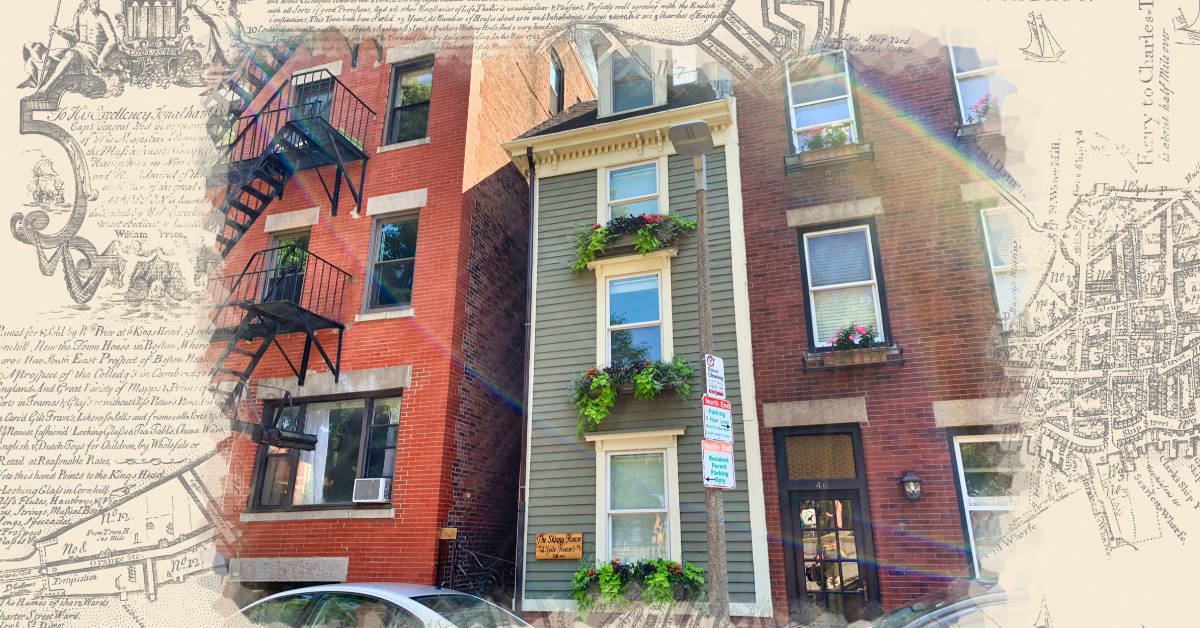
Seven Things I Learned about this Location
Joseph Eustis, a shipbuilder, built the house in 1804 - Listed as one of the 100 oldest building in Boston. (Some records have the house being built in 1884.)
He was forced to build the house of that size because his brother built a larger house on a property by their deceased Dad. He challenged Joseph to try to build a house on such a small piece of property.
This four-story house features 1 bed, 1 bath. The total living space is 1166 sq. ft. The bedroom is 800 sq ft. There are only 4 doors in the entire house.
The House spans 10.4 feet at the widest point.
You can only enter the house in the back alley. Did you notice that there's no front door on Hull Street?
The house was Last sold on May 18, 2017 for $900,000 or $771 a sq ft. Today the house is valued at $1,044,111. At one time you could rent this property for $2,500 a month.
Today as you walk by the house you'll see a sign that reads, "The Skinny House (Spite House) Est. 1862." The term Spite House refers to how Joseph Eustis built the house to irritate his brothers for not leaving him enough land. Instead of keeping the space empty he built a house to block the sun from his brother's house.
PermalinkJFK Thanksgiving Proclamation
JFK Thanksgiving Proclamation
The 35th President of the United States gave the following Thanksgiving Proclamation 57 years ago:
Over three centuries ago in Plymouth, on Massachusetts Bay, the Pilgrims established the custom of gathering together each year to express their gratitude to God for the preservation of their community and for the harvests their labors brought forth in the new land. Joining with their neighbors, they shared together and worshipped together in a common giving of thanks. Thanksgiving Day has ever since been part of the fabric which has united Americans with their past, with each other and with the future of all mankind.
It is fitting that we observe this year our own day of thanksgiving. It is fitting that we give our thanks for the safety of our land, for the fertility of our harvests, for the strength of our liberties, for the health of our people. We do so in no spirit of self-righteousness. We recognize that we are the beneficiaries of the toil and devotion of our fathers and that we can pass their legacy on to our children only by equal toil and equal devotion. We recognize too that we live in a world of peril and change--and in so uncertain a time we are all the more grateful for the indestructible gifts of hope and love, which sustain us in adversity and inspire us to labor unceasingly for a more perfect community within this nation and around the earth.
Now, Therefore, I, John F. Kennedy, President of the United States of America, in accord with the joint resolution of Congress, approved December 26, 1941, which designates the fourth Thursday in November of each year as Thanksgiving Day, do hereby proclaim Thursday, the twenty-second day of November of this year, as a day of national thanksgiving.
I urge that all observe this day with reverence and with humility.
Let us renew the spirit of the Pilgrims at the first Thanksgiving, lonely in an inscrutable wilderness, facing the dark unknown with a faith borne of their dedication to God and a fortitude drawn from their sense that all men were brothers.
Let us renew that spirit by offering our thanks for uncovenanted mercies, beyond our desert or merit, and by resolving to meet the responsibilities placed upon us.
Let us renew that spirit by sharing the abundance of this day with those less fortunate, in our own land and abroad. Let us renew that spirit by seeking always to establish larger communities of brotherhood.
Let us renew that spirit by preparing our souls for the incertitude's ahead--by being always ready to confront crisis with steadfastness and achievement with grace and modesty.
Let us renew that spirit by concerting our energy and our hope with men and women everywhere that the world may move more rapidly toward the time when Thanksgiving may be a day of universal celebration.
Let us renew that spirit by expressing our acceptance of the limitations of human striving and by affirming our duty to strive nonetheless, as Providence may direct us, toward a better world for all mankind.
In Witness Whereof, I have hereunto set my hand and caused the seal of the United States of America to be affixed.
DONE at the City of Washington this 7th day of November, in the year of our Lord nineteen hundred and sixty-two, and of the Independence of the United States of America the one hundred and eighty-seventh.
Fake Monks
Fake Monk signs at Faneuil Hall
As you walk around Faneuil Hall and Quincy Market you may see some strange signs. One of these signs are warnings about the Fake Monk Mafia.
These signs seem a bit out of place, and certainly make people think - why are these signs here? What are these people doing that so bad?

Things I Learned About the Signs
- The notices started going up around the summer of 2016.
- This is part of the North End Waterfront council community to inform people of the panhandlers.
- The signs were put up in various places around the North End informing tourist about the fake panhandlers.
- Local merchants were annoyed about these people asking for money for a fake cause.
- The scam is that they slide a bracelet on your wrist and insist that you make a donation to their cause.
- Recent sightings have been near the Holocaust Memorial and around Park Street Station.
Not a Boston Problem
The Fake Monks are a problem in major cities around the world. Just about every popular tourist spot has men posing as Buddist monks harassing passers-by for money and react angrily when told no or when ignored.
Stories from around the Internet:
- New York Post - Fake Buddhist monks are the new squeegee men of New York (June 15, 2015)
- KRON (San Francisco) - People Behaving Badly: More San Francisco fake monks
- Inside Chicago - Avoid Fake Monks in Chicago
- South China Morning Post - Six ways to spot a fake Buddhist monk after Hong Kong ex-actress Mary Jean Reimer on crusade to expose them strikes again
Sign Text
The text on the sign reads:
Do Not Give Money to the Fake Monk Mafia!
These are not real monks. They have been harassing our visitors - please do not encourage them by giving them money.
Is you are being harassed by one of these individuals. please call Faneuil Hall Marketplace Security: 1-857-208-1585.
Commodore John Barry
Commodore John Barry monument on the Boston Commons
In the Boston Commons is a commemorated plaque of Commodore John Barry. It lists all the accomplishments that he did to help win the American Revolution.
John Barry was an officer in the Continental Navy during the American Revolutionary War and later in the United States Navy. He has been credited as being "The Father of the American Navy" and was appointed a captain in the Continental Navy on December 7, 1775.
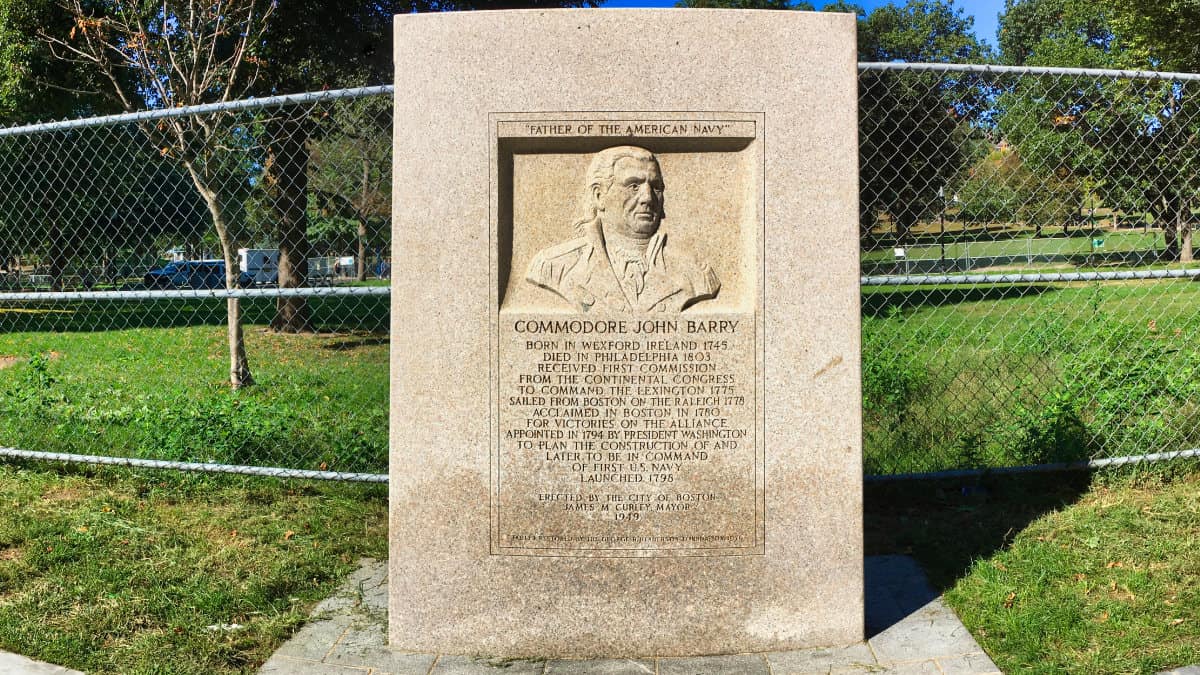
Interesting Facts about John Barry and the Memorial.
- John Barry was born on March 25, 1745 and Died on September 13, 1803.
- The tablet was commissioned in 1949 by Boston’s Mayor James Michael Curley. The Mayor felt bad that there wasn't a memorial to John Barry - he wanted Bostonians to remember John Barry. The tablet was placed on the Boston Commons on October 16, 1949.
- On April 5, 1975, the tablet was stolen allegedly by some college students. It was mysteriously returned a few years later. The original tablet is now hanging in the USS Constitution Museum at the Charlestown Navy Yard.
- The original tablet was done by John Francis Paramino - who also did the Founders Memorial and the Declaration of Independence memorial and the John Endicott Resident Plaque among many others around the City of Boston.
- The Henderson Foundation funded the granite reproduction in 1977.
- President Kennedy displayed John Berry sword in the Oval Office - he admired John Barry. The sword is now in the John F. Kennedy Presidential Library and Museum.
- Four United States Navy ships have been named in honor of him.
- John Barry is buried in Philadelphia, Pennsylvania.
Text of the Memorial
Father of the American Navy Commodore John Barry Borm in Wexford Ireland 1745 Died in Philadelphia 1803 Received First Commission From the Continental Congress To Command the Lexington 1775 Sailed from Boston on the Raleigh 1778 Acclaimed in Boston in 1780 For Victories on the Alliance Appointed in 1794 By President Washington To Plan the Construction of And Later to be in Command Of First U.S. Navy Launched 1798 Erected by the City of Boston James M Curley Mayor 1949 Tablet restored by the George B. Henderson Foundation, 1976
Located
The Tablet is located on the Boston Commons on Tremont Street near Template Place.
PermalinkPalazzo Ducale Model in the North End
Cool replica of the Palazzo Ducale building in Venice in Boston's North End
The Boston Public Library central branch in Copley Square is famous for its architecture and collection. There are 25 other libraries scattered around the city with each one offering something special and unique to visitors.
In the North End, the Boston Public Library branch is located on 25 Parmenter Street.
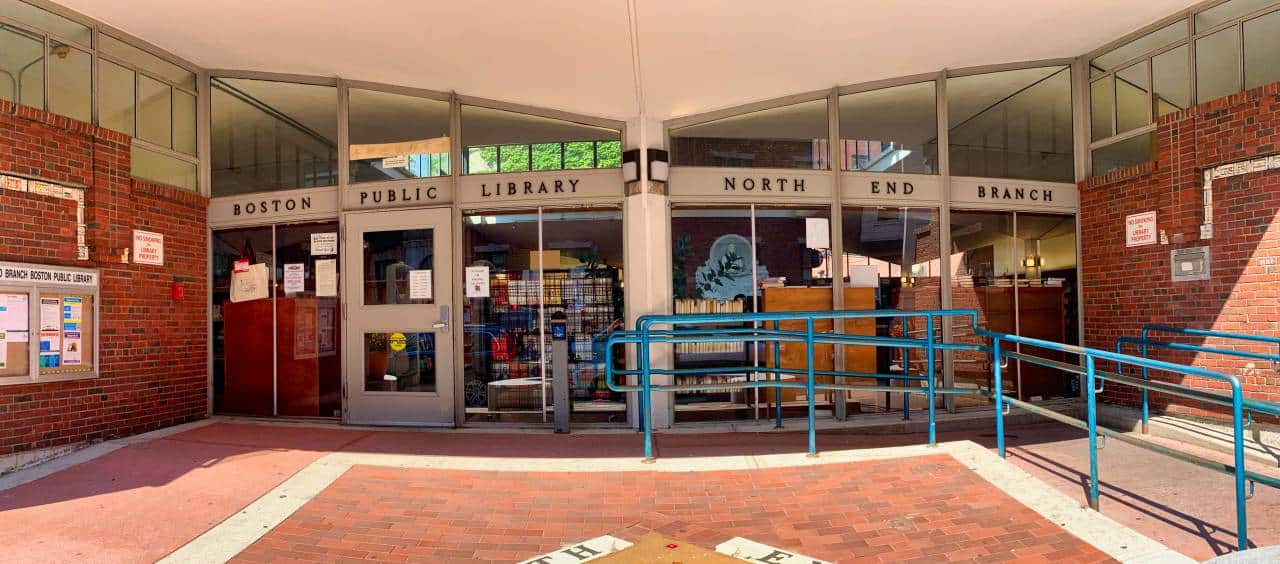
Entrance to the North End Branch.
Why Visit?
There are Three Reasons to visit the North End Library branch:
- The building architecture is based on a Roman Villa. (There is a tiny courtyard in the center of the library that has plants.)
- There's a scale model of the Palazzo Ducale in Venice constructed by Henrietta Macy and Louise Stimson.
- There's a white marble bas-relief of Dante Alighieri in the center court.
The scale model of the Palazzo Ducale in Venice is a hidden treasure of Boston's North End and worth checking out!
Five Things I Learned About the Palazzo Ducale
The model isn't not visible to see when you walk in the Library. As you walk in, keep going straight. the model is located on the center wall facing away from the main entrance.
The model was put in the library in the 1930s. In 2013, the model underwent a complete restoration.
The model shows the scene of Venice from the 1500s, with political dignitaries and patricians.
There's a pamphlet that you can get that describes the model and people to look for in the model. Makes for a great treasure hunt for kids! (Can you find the begger wearing a black hood to hide his identity.)
There is a book all about the life and times of Miss Henrietta Gardner Macy. .Amazon.com: The Nun of the CA'Frollo: Life and Letters of Henrietta Gardner Macy (9781258057381): Clementine Bacheler, Jessie Orr White, Henrietta Gardner Macy: Books. Yes, you can get the book from the library!

The Story of the Model
An abbreviated version of the story behind the Palazzo Ducale model:
The model was requested to be built by a former kindergarten teacher (Miss Henrietta Gardner Macy) that taught in the North End. She wanted to live in Europe, and when the opportunity came she left and headed to Italy
Miss Macy kept contact with her Boston friends by writing. A couple of Boys visited her and helped her build a model of the Palace. The Boys had fun and promised to finish the project when they returned to Venice. The boys caught some bacterial infection and died.
Miss Macy was very sad to hear of the news. She decided to honor the boys by building a larger scale model. She worked hard on the model and the New York Metropolitan Museum showed interest in buying it. However, it was destroyed in a fire in England.
Miss Macy went back to the drawing board and made another model - this one to be bigger and better. Miss Macy died in 1927 without finishing the model.
Miss Nina C. Mitchell, one of her friends, decided to hire some craftmen to finish the job. Once completed, it was donated to the library for the enjoyment of the neighborhood.
PermalinkMather Tomb
Some people say that Increase Mather haunts Copp's Hill Burying grounds.
One of the legends about Copp’s Hill Burying Ground is that of Reverend Increase Mather. Some people that he appears to certain visitors in the cemetery, scaring them as they walk around the graves.
I did some research and couldn't find any information about the appearances other than it happens at night. Which is weird because Copp's Hill Burying Ground is closed at dusk.
Increase Mather is famous for saying in his “Case of Conscience†- “It is better that ten witches go free than the blood of a single innocent be shed.â€Â
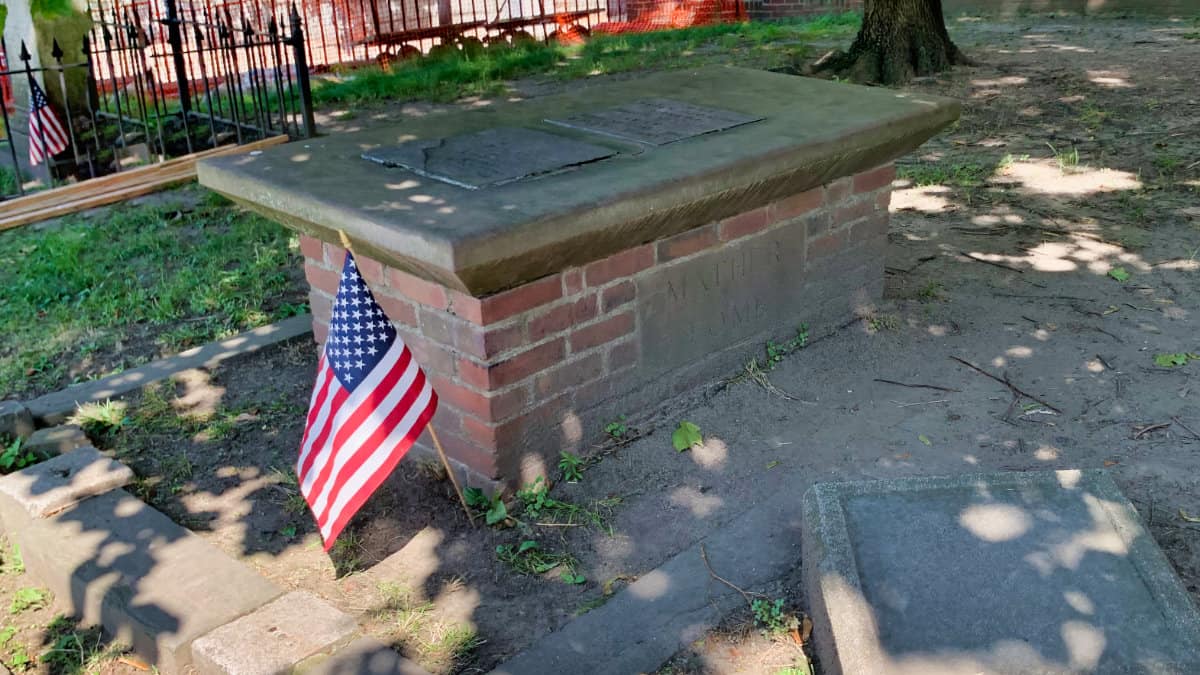
Interesting Facts About the Mather’s Tomb
There once was an iron fence around the tomb. (If you look at the stones around the tomb you can see the fence pole markers.)
Near the Tomb is a weeping willow which was raised from a slip taken from a tree that grew over the tomb of Napoleon at the Island of St. Helena. The slip was brought over by Captain Joseph Leonard. It was planted in 1844.
There’s a rumor that the tomb itself was actually built by Cotton Mather. Some say the proof is in his diary writing: “The Lord gave me to see wondrous demonstrations of the love his and my people had for me. One was their building a costly tomb for the ashes of my lovely consort, and of my children, whereof there were five buried, with no more than common gravestones.â€Â
The tomb contains the final remains of Cotton Mather’s children, his father, and several other relatives.
Cotton Mather was three times married; he had fifteen children from his first 2 wives.
The last time the tomb was open was in 1884 when a member of the Parker family was deposited into the tomb.
Top of the Tomb
On the top of the tomb is the following inscription, which is barely illegible today:
Mather Tomb.
The Reverend Doctors
Increase--Cotton
& Samuel Mather
Were entered in this vault.
Tis the Tomb of our Fathers
Mather. Crockers.
I died Aug 27, 1723 AE 84
C died Feb. 13, 1727 AE 65.
S died June 27, 1785 AE 79.
Sign Near the Tomb
On the ground in front of the tomb is the following sign:
Mather Family Tomb
Several generations of great 17th and 18th century New England divines are buried here. Increase (1639-1723),. the father; Cotton (1663-1728) the son; and Samuel Mather (1706-1785) the grandson’s belonged to a remarkable family of ministers. At a time when the church wielded its own power and religious zeal translated into political influence, the Mather’s ecclesiastical attainments assured them secular authority.
Increase was the sixth son of Richard, who was first of the Mather dynasty and a minister in Dorchester. Increase graduated from Harvard in 1656 and within a decade began a 60-year ministry to the 2nd Church of Boston. Later, he was named the president of Harvard. As a powerful statesman, Increase represented Massachusetts at the British Court and tried to secure a new, beneficial charter for the Colony in the early 1690s/ This effort and his role as personal advisor to the new Royal Governor, Sir William Phips, attracted such resentment that he was forced to resign as Harvard president and lose his political power. Increase spent his last days in the North End where he had lived much of his life and had raised his 10 children.
Archbald Gravestone
Interesting story with the Archbald family in American History
There are many famous gravestones at the Granary Burial Grounds of people that contributed to the American Revolution. One of the overlooked gravestones is the Archbald family. It's the Number 2 gravestone in the Granary Burying Grounds.
This single gravestone has 21 family members listed, six of them were children of Francis and Anna Archbald.
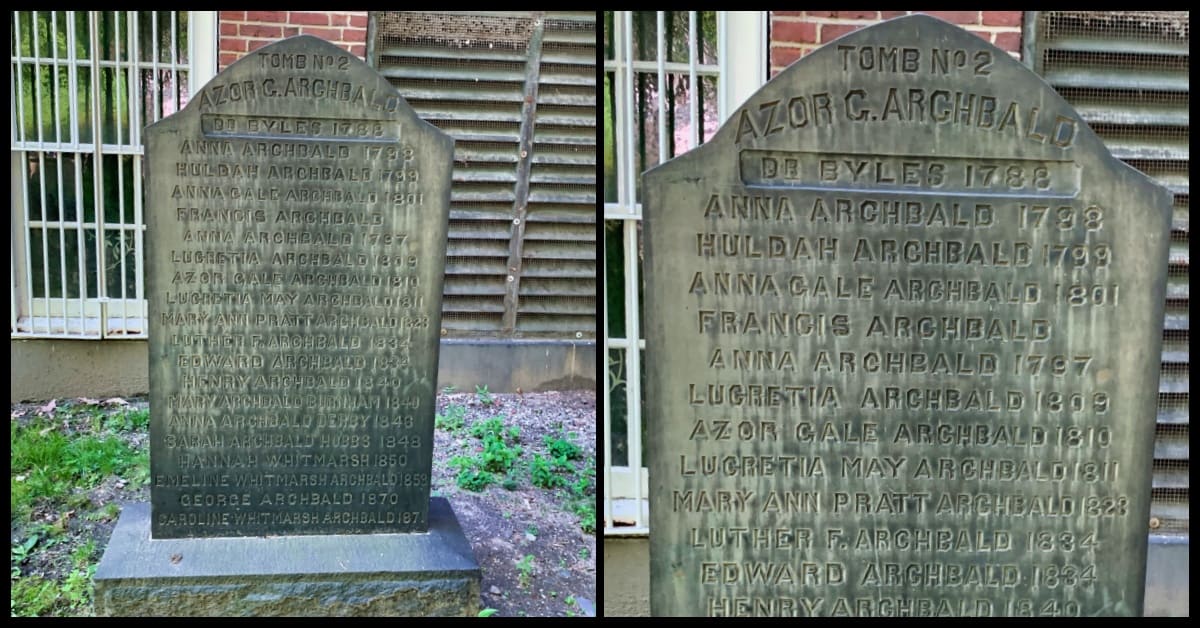
GraveStone Listing
Azor G. Archbald d. 1811
Dr. Byles 1788
Anna Archbald 1798
Huldah Archbald 1799
Annagale Archbald 1801
Francis Archbald 1801
Anna Archbald 1797
Lucretin Archbald 1809
Azor Gale Archbald 1810
Lucretian May Archbald 1811
Mary Ann Pratt Archbald 1823
Luther F. Archbald 1834
Edward Archbald 1834
Henry Archbald 1840
Mary Archbald Burnha, 1840
Anna Archbald Derby 1846
Sarah Archbald Hobbs 1848
Hannah Whitmarsh 1850
Emeline Whitmarsh Archbald 1853
Geroge Archbald 1870
Caroline Whitmarsh Archbald 1871
Story #1: Dr. Mather Byles
Dr. Byles is actually Mather Byles. He was a high ranking clergy at the Hollis Street Church (Congregational) He graduated from Harvard College and received his doctoral degree from the University of Aberdeen in Scotland.
During the Revolution he was an advocate of British rule. Despite his loyalty to the British, he was captured during the British Occupation of Boston. He was under house arrest while the British occupied the town.
It's unclear on why he was arrested - other than his refusal to leave his home and the Hollis Street Church.
His famous saying was, "Which is better - to be ruled by one tyrant three thousand miles away or by three thousand tyrants one mile away?"
He died on July 5, 1788. He is the Father in Law of Azor G Archbald.
Side Note: I am not sure why Mather Byles full name isn't on the gravestone and why his name isn't listed on the Official Granary Burying Ground Cemetery Records.
Story #2: Boston Massacre Participant
Edward Archbald and Francis Archbald were two brothers that had some minor role of a series of events that eventually led to the Boston Massacre.
According to the Boston Gazette, a publication that reported on the events of the American Revolution, this is what happened:
On March 5th, 1770, four boys - Edward Archbald, William Merchant, Francis Archbald, and John Leech arrived at Cornhill (A Street in Colonial Boston - which is where City Hall is today.)
As the four boys were walking down a narrow alley, Edward Archbald bumped into a British soldier sword. He asked the soldier to move the sword so others wouldn't bump into it. The Solder turned around and hit Edward on the arm and poked the sword at William Merchant.
William hit the soldier with a stick he had in his hand. One of the other soldiers ran to get an assistant.
One of the solders that came to help chased Edward in the alley and corned him. The soldier then "laid him over the head with the tongs."
This commotion attracted other people to see what was going on. The soldiers took the boys over to the nearby barracks and stood by them. After a few moments, more people showed up - some with clubs and bayonets.
After a while the boys left - since they didn't have the fighting equipment other had.
The ensuing mob would later start harassing the British. The British would later fire on the mob killing three instantly and two others died a few days later.
The two boys Edward Archbald and Francis Archbald are buried in the Archbald tomb. One of the other boys - John Leech is also buried in the Granary Burying Grounds.
Finding the Gravestone
The Archbald gravestone is in the back left corner of the Granary Graveyard - along the brick wall.
PermalinkThomas Seward Gravestone
Intersting information about Thomas Seward
Walking through the North End's Copp's Hill Burying Ground you will see a lot of unique gravestones. One is Major Thomas Seward, who died on November 27, 1800.
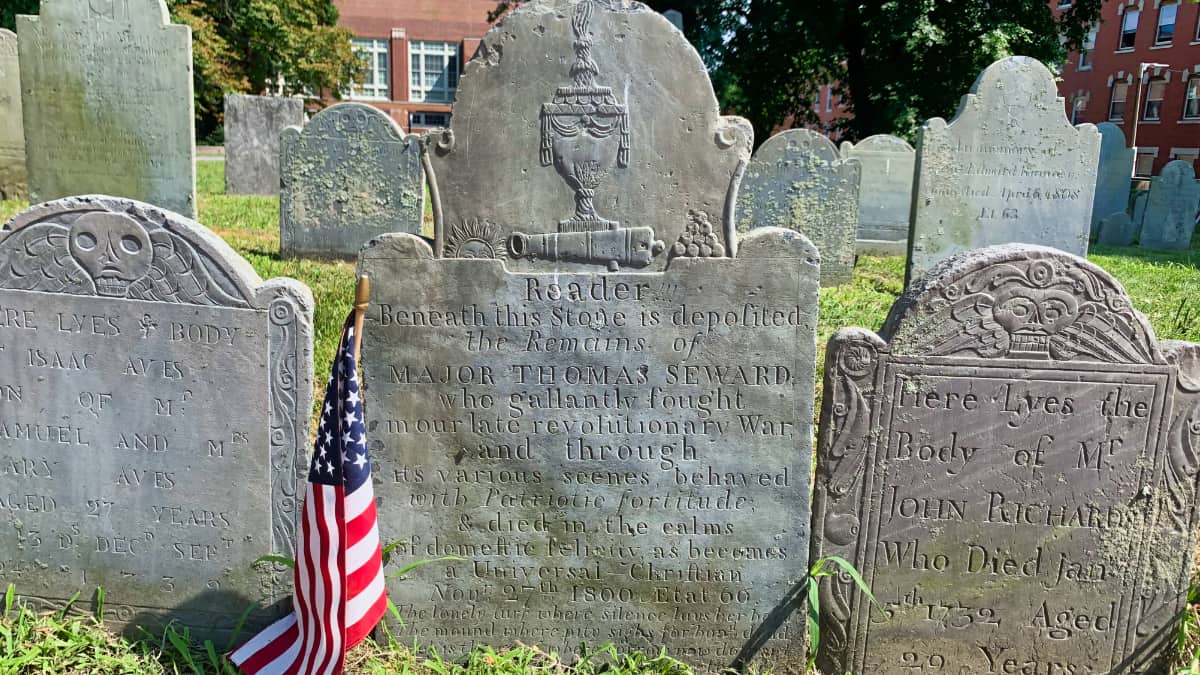
Click on image for a larger version.
Gravestone Text
Beneath this Stone is deposited
the Remains of
MAJOR THOMAS SEWARD
who gallantly fought
in our late revolutionary War
and through
its various seenes, behaved
with Patriotic fortitude
& died in the calms
of domestic Felicity as becomes
a Universal Christian,
Nov 27th, 1800, AE at 60.
On the bottom of the grave is this phrase, which is slowing disappearing into the ground:
The mound where pity sighs for hon'd dead,
Such is the grief where sorrow now doth sigh,
To learn to live is but to learn to die."
Three Things I Learned
Some things I learned while researching the history of Thomas Seward.
There isn't much information about Thomas Seward. No information on what battles that Thomas Seward participated in. No information about his life before and after the war.
When he died local papers were quick to point out his death and how he was a major contributor to the Revolution.
He was married to Sarah Seward. She died seven months before Thomas. She is also buried in the same grave - but interestingly enough, there's no mention of her name on the grave. Even though she was buried there first!
They had a son named Thomas he was born in 1770 and died in 1852. He is buried in Weymouth, Massachusetts.
Gravestone Images
On the gravestone, there are various symbols. According to the Cemetery Club, here's what each one means:
- Setting Sun - Death
- Urn, draped - Connotes death, often of an older person.
- Cannon - Military service.
Reference Log
This is the log entry in the Massachusetts Soldiers and Sailors of the Revolutionary War book. There was only one entry for Seward, Thomas:
Seward, Thomas. Captain, Col. John Crane’s (Artillery) regt. ; Continental Army pay accounts for service from Jan. 1, 1777, to Dec. 31, 1780; also, return of officers for clothing ; receipt for said clothing, dated Boston, May 26, 1778, and signed by Col. Crane; also, muster roll for May 1778, dated Camp Valley Forge; commissioned Jan. 1, 1777; also, return of officers for clothing, certified at Boston, Sept. 25, 1778 ; also, list of officers who were to continue in the service, as returned by Thomas Vose, Captain and Adjutant, dated Boston, Jan. 19, 1781; also, receipt given to Capt. Lieut. Knowles, signed by said Seward and others belonging to Col. Crane’s (3d Artillery) regt., for subsistence money for June, 1782.
Doctor Joseph Warren
Some Information about Doctor Joseph Warren
Doctor Joseph Warren was an American physician who played an important role in the early days of the American Revolution.
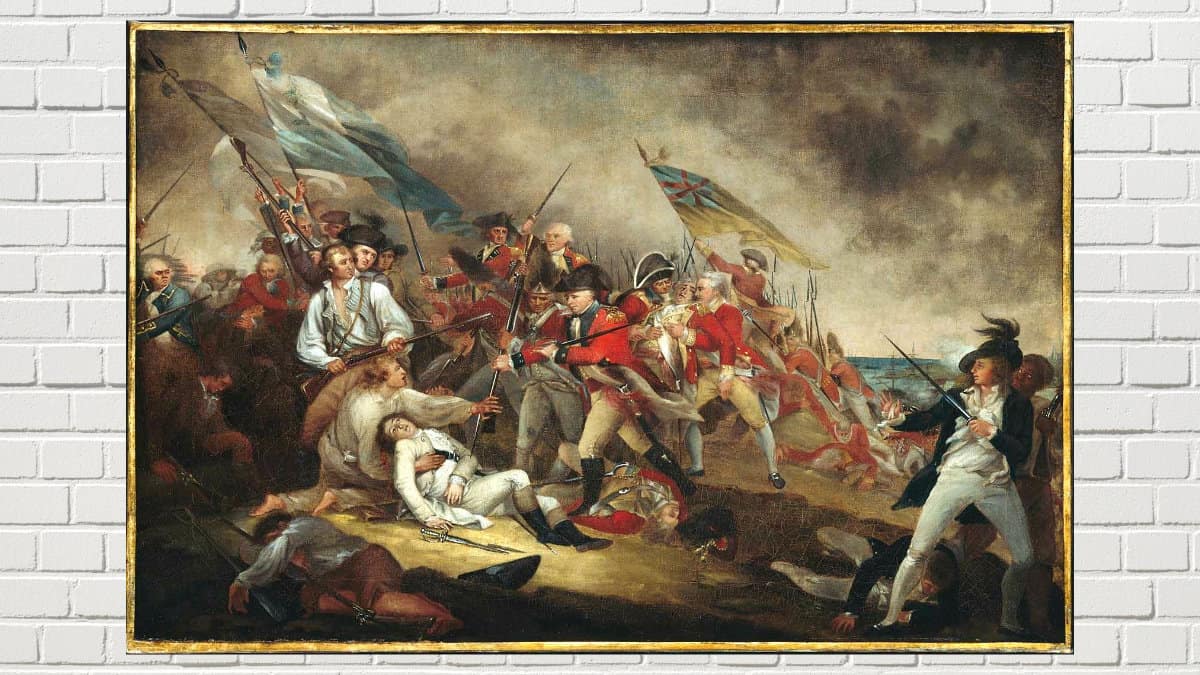
"The Death of General Warren at the Battle of Bunker Hill" at the Boston's Museum of Fine Arts.
Eight Things I Learned about Joseph Warren
- Married to Elizabeth Hooten on September 6, 1764.
- They had four children: Elizabeth, Joseph, Mary and Richard.
- Practicing Physician who attend school at Harvard College.
- Grand Master of the Provincial Grand Lodge of Massachusetts.
- Conducted the autopsy on Christopher Seider shortly after he was shot. Some people believe that Christopher Snider is considered to be the first martyr of the Revolutionary War.
- He gave William Dawes and Paul Revere the responsibility to alert John Hancock and Samuel Adams of the approaching British Army on the night of April 18, 1775.
- Elected President of the Massachusetts Provincial Congress and was appointed general of Massachusetts troops.
- Fought with William Dawes at the Battle of Bunker Hill (Breed's Hill). He died at the first day of battle.
Body Reburied Around Many Time
After Death, Doctor Joseph Warren body was relocated many times:
First Burial
- Buried by the British Captain Walter Laurie, the British Commander who led the troops to Concord's North Bridge, at Breed's Hill.
Second Burial
Third Burial
- In 1824, he was exhumed and moved to the family valt under St. Paul's Cathedral.
Forth Burial
- In 1865, his remains were moved to the Warren family plot at Forest Hills Cemetery
Christopher Snider
a forgotten Patriot of the American Revolution
At the Granary Burying Grounds are buried some of the most important patriots that help shape this nation. You can find Paul Revere, John Adams, and many more Patriots.
One of the "famous" gravestones that you'll encounter near John Adams is the one for those that died as a result of the Boston Massacre.
If you look carefully you'll notice that a young 12-year old boy is buried that died a few weeks before the Massacre is also buried there.
This is the story of a forgotten Patriot of the American Revolution:
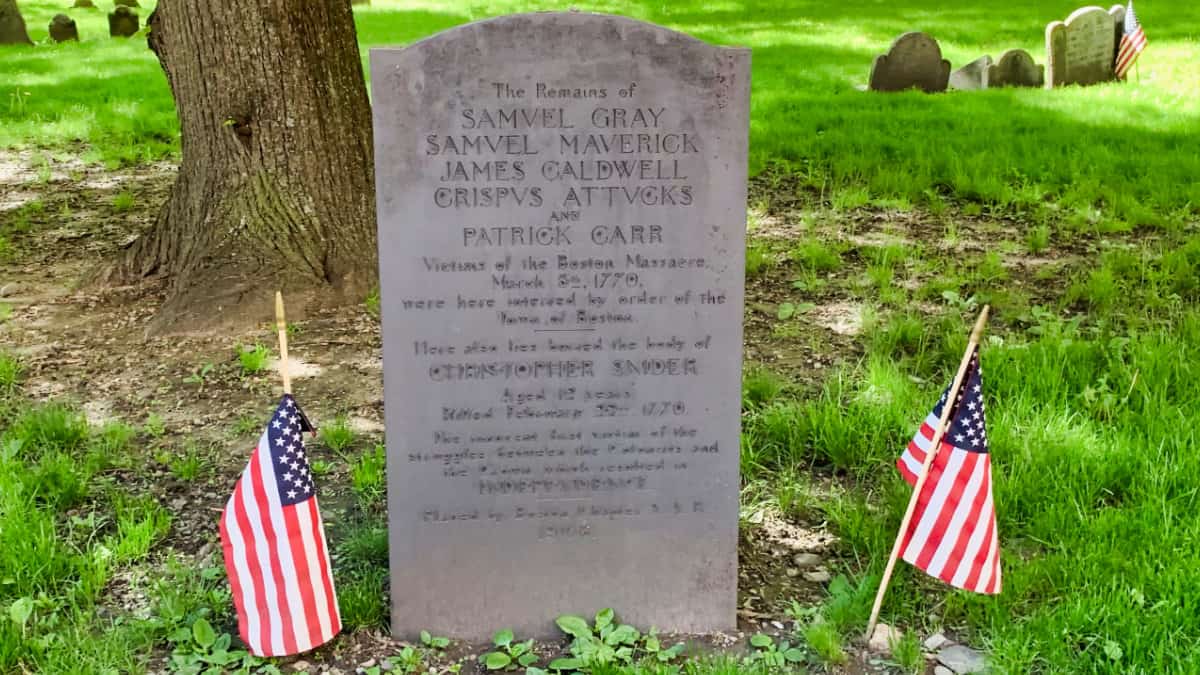
The Christopher Snider Story
On February 22, 1770, a crowd gathered at a shop on Hanover Street complaining about how a store, owned by Theophilus Lillie, was selling imported tea. The Sons of Liberty put up a sign on the shop letting people know that it was selling imported team.
Ebenezer Richardson, a customs informer, with some bad ties with the Sons of Liberty, tried to take down the sign. The crowd got angry and he was chased back to his home.
Once he arrived home some of the boys in the crowd started throwing snowballs and rocks at Ebenezer's house. Ebenezer went upstairs and fired several shots on the crowd injuring Christopher Gore and instantly killing Christopher Snider.
Christopher Snider body was immediately taken to Faneuil Hall.
John Adams arranged a funeral a couple of days later. The funeral procession started at Faneuil Hall and proceed to the Liberty Tree and finally to Granary Burying Grounds. Local reports about 5,000 people attended the funeral procession. Hundreds of children and dignitaries attended the process.
John Adams said, "My eyes never beheld such a funeral."
On foot of his coffin are the Latin words, "latet anguis in hebra!" which means, "a snake hides in the grass." On the head of the coffin is the inscription: "Innocence is nowhere safe."
Ebenezer Richardson barely avoid a lynching by the crowd and was tried for his crime. He was found not guilty and moved to Philadelphia.
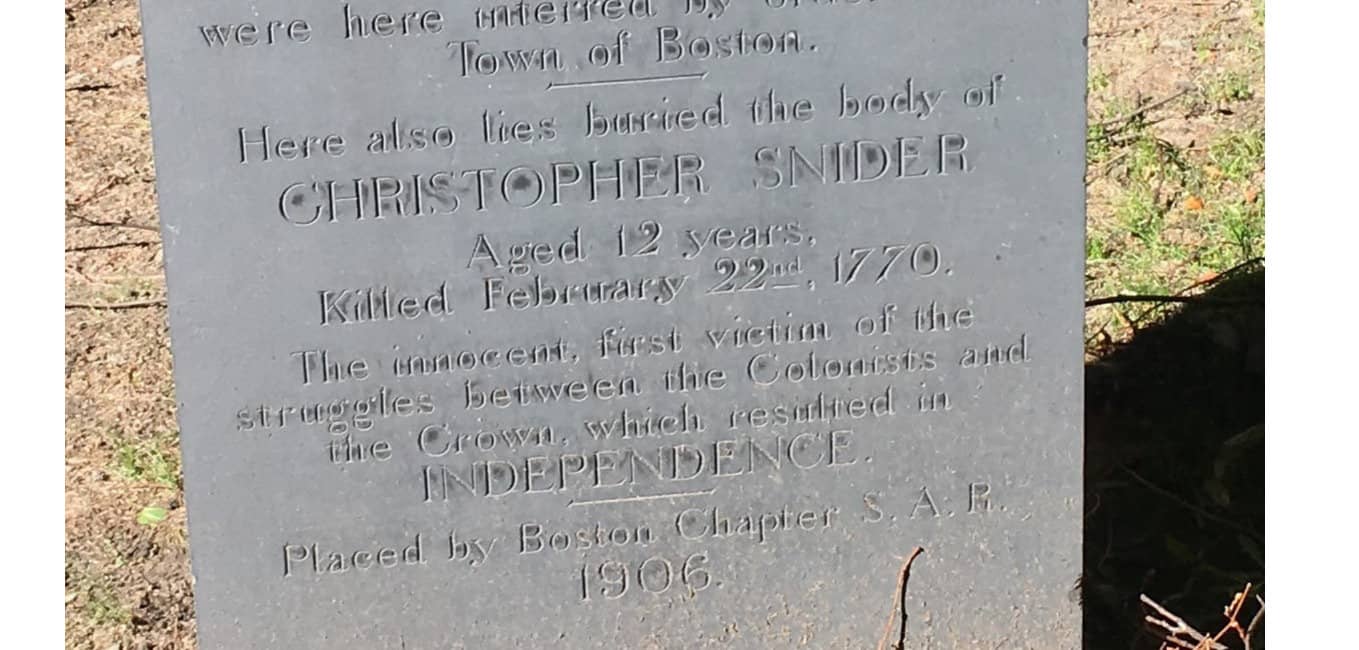
Things I Learned about Christopher Snider
Name on the gravestone is spelled Christopher Snider but it's also known as Christopher Seider in some British print.
Christopher Snider was born in 1758. (His exact birthdate is not known.)
After his death the Sons of Liberty were making plans to build a monument to honor Christopher Snider - that never happened.
According to the Son's of Liberty, Christopher Snider is considered to be the first martyr of the Revolutionary War.
On March 8th, 1899 the single stone was placed on the existing gravesite - it was the first time that the names of the Boston Massacre and Christoper Snider were on the same marker . On May 30, 1906, the Sons of the American Revolution dedicated a new Boston Massacre memorial. This is the memorial that you see today.
On the old tablet, Christopher Snider is mention on the backside - "Here lies buried the body of Christopher Snider, aged about 12 years. Killed Feb. 22, 1770. The innocent, first victim of the struggle between the colonists and the crown, which resulted in independence."
PermalinkAbout
There are many interesting things and places around Boston, MA that you should know about. Here are a few that caught my attention. From historical sites such as the USS Constitution Museum, the Freedom Trail, and the iconic Fenway Park, to modern attractions like the New England Aquarium, the Boston Public Market, and the Isabella Stewart Gardner Museum, there is something for everyone. Whether you are looking for a fun family trip or a romantic getaway, Boston has it all.
Check out all the blog posts.
Blog Schedule
| Saturday 12 | Internet Tools |
| Sunday 13 | Misc |
| Monday 14 | Media |
| Tuesday 15 | QA |
| Wednesday 16 | Pytest |
| Thursday 17 | PlayWright |
| Friday 18 | Macintosh |
Other Posts
- Boston Public Gardens Foot Bridge
- Boston Guide Sign
- Patriots Day Weekend
- Boston Blog Update
- House of Blues
- Durgin Park
- Signs of Spring in Boston
- Commodore John Barry
- Prudential Skywalk Observatory
- Henry and Paint
- Norman B. Leventhal Map & Education Center
- Best Boston Blog Post of 2017
- The Christian Science Plaza
- Cows on the Boston Commons
- Boston Santa